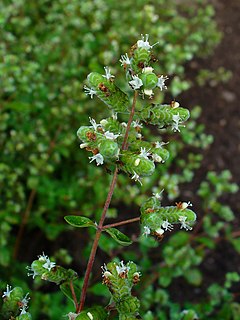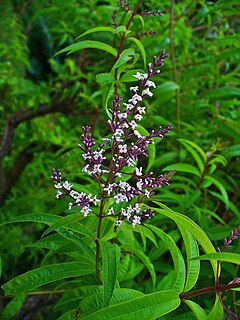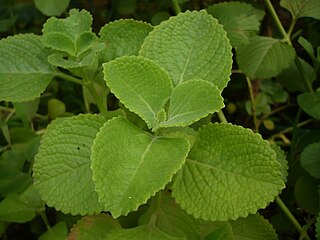| Look up oregano in Wiktionary, the free dictionary. |
Oregano (Origanum vulgare) is an herb commonly used in cooking.
Oregano may also refer to:
| Look up oregano in Wiktionary, the free dictionary. |
Oregano (Origanum vulgare) is an herb commonly used in cooking.
Oregano may also refer to:

Marjoram is a cold-sensitive perennial herb or undershrub with sweet pine and citrus flavours. In some Middle Eastern countries, marjoram is synonymous with oregano, and there the names sweet marjoram and knotted marjoram are used to distinguish it from other plants of the genus Origanum. It is also called pot marjoram, although this name is also used for other cultivated species of Origanum.

Oregano is a species of flowering plant in the mint family Lamiaceae. It was native to the Mediterranean region, but widely naturalised elsewhere in the temperate Northern Hemisphere.

Thyme is the herb of some members of the genus Thymus of aromatic perennial evergreen herbs in the mint family Lamiaceae. Thymes are relatives of the oregano genus Origanum. They have culinary, medicinal, and ornamental uses, and the species most commonly cultivated and used for culinary purposes is Thymus vulgaris.

Herbes de Provence is a mixture of dried herbs considered typical of the Provence region of southeastern France. Formerly simply a descriptive term, commercial blends started to be sold under this name in the 1970s. These blends often contain savory, marjoram, rosemary, thyme, and oregano. Lavender leaves are also included in products in the North American market. The herb mixture is typically used with grilled foods and stews.

Aloysia citrodora, lemon verbena, is a species of flowering plant in the verbena family Verbenaceae, native to South America. Other common names include lemon beebrush. It was brought to Europe by the Spanish and the Portuguese in the 17th century and cultivated for its oil.

Coleus amboinicus, synonym Plectranthus amboinicus, is a semi-succulent perennial plant in the family Lamiaceae with a pungent oregano-like flavor and odor. The origin of Coleus amboinicus is unknown, but it may be native to Africa, and possibly India. Coleus amboinicus is widely cultivated and naturalized elsewhere in the tropics where it is used as a spice and ornamental plant. Common names in English include Indian borage, country borage, French thyme, Indian mint, Mexican mint, Cuban oregano, soup mint, Spanish thyme. The species epithet, amboinicus refers to Ambon Island, in Indonesia, where it was apparently encountered and described by João de Loureiro.

Dysphania ambrosioides, formerly Chenopodium ambrosioides, known as Jesuit's tea, Mexican-tea, payqu(paico), epazote, mastruz, or herba sanctæ Mariæ, is an annual or short-lived perennial herb native to Central America, South America, and southern Mexico.
Carvacrol, or cymophenol, C6H3(CH3)(OH)C3H7, is a monoterpenoid phenol. It has a characteristic pungent, warm odor of oregano.

Picadillo is a traditional dish in many Latin American countries and the Philippines. It is made with ground meat, tomatoes, and also raisins, olives, and other ingredients that vary by region. It is often served with rice or used as a filling in dishes such as tacos, savory pastries or croquettes. The name comes from the Spanish word picar, meaning "to mince".

Lippia is a genus of flowering plants in the verbena family, Verbenaceae. It was named after Augustus Lippi, (1678-1705), a French naturalist and botanist. He was killed in Abyssinia. The genus contains roughly 200 species of tropical shrubs that are found around the world. Plants are fragrant due to their essential oils, which vary between species but may include estragole, carvacrol, linalool, or limonene. The leaves of certain species, such as L. graveolens, can be used as a culinary herb similar to oregano.

Phyla dulcis is a species of perennial herbaceous plant that is native to southern Mexico, the Caribbean, Central America, Colombia, and Venezuela. It is known by several common names, including Aztec sweet herb, bushy lippia, honeyherb, hierba dulce, and tzopelic-xihuitl (Nahuatl). Its buds are also sold as dushi or dulce buttons.

Hernandulcin is an intensely sweet chemical compound gained from the chiefly Mexican and South American plant Lippia dulcis.

Lippia alba is a species of flowering plant in the verbena family, Verbenaceae, that is native to southern Texas in the United States, Mexico, the Caribbean, Central America, and South America. The species is also present in Australia and India, where it is probably a human introduction. Common names include bushy matgrass, bushy lippia, hierba negra, juanilama,pamporegano, and pitiona. It is a multi-branched shrub, reaching a height of 1.5 m (4.9 ft). Leaves measure 1 to 3 cm in length and 0.9 to 2 cm in width and are opposite or in threes. Flowers with white, pink, or light blue-purple corollas form on spikes 2 cm (0.79 in) long.

Lippia graveolens, a species of flowering plant in the verbena or vervain family, Verbenaceae, is native to the southwestern United States, Mexico, and Central America as far south as Nicaragua. Common names include: Mexican oregano, redbrush lippia, orégano cimarrón, scented lippia, and scented matgrass. The specific epithet is derived from two Latin words: gravis, meaning 'heavy', and oleo, meaning 'oil'. It is a shrub or small tree, reaching 1–2.7 m (3.3–8.9 ft) in height. Fragrant white or yellowish flowers can be found on the plant throughout the year, especially after rains.
Poliomintha is a genus of flowering plants in the mint family, Lamiaceae. It is native to the southwestern United States, Haiti, and northern Mexico.
Hedeoma patens is a small herb in the genus Hedeoma, family Lamiaceae. It is native to the Mexican states of Chihuahua and Coahuila. It is not very closely related to true oregano.

Lippia abyssinica, or koseret, is a species of flowering plant in the verbena family, Verbenaceae. It is endemic to Ethiopia but cultivated throughout tropical African countries. The specific epithet abyssinica derives from Latin and means 'of or from Ethiopia (Abyssinia)'.
L. abyssinica can refer to a few different species. The specific epithet abyssinica refers to Ethiopia, where many of these species may be found.
Sorol is a Filipino dish consisting of chicken cooked in a coconut milk-based broth primarily made with ginger, Mexican oregano (kalabo), labuyo chili, and tomatoes. The dish originates from the island of Camiguin. It is a type of ginataan. It can also be made with pork, beef, or seafood. Mexican oregano may be difficult to acquire and thus some versions use other herbs like lemongrass, other types of oregano or sage.